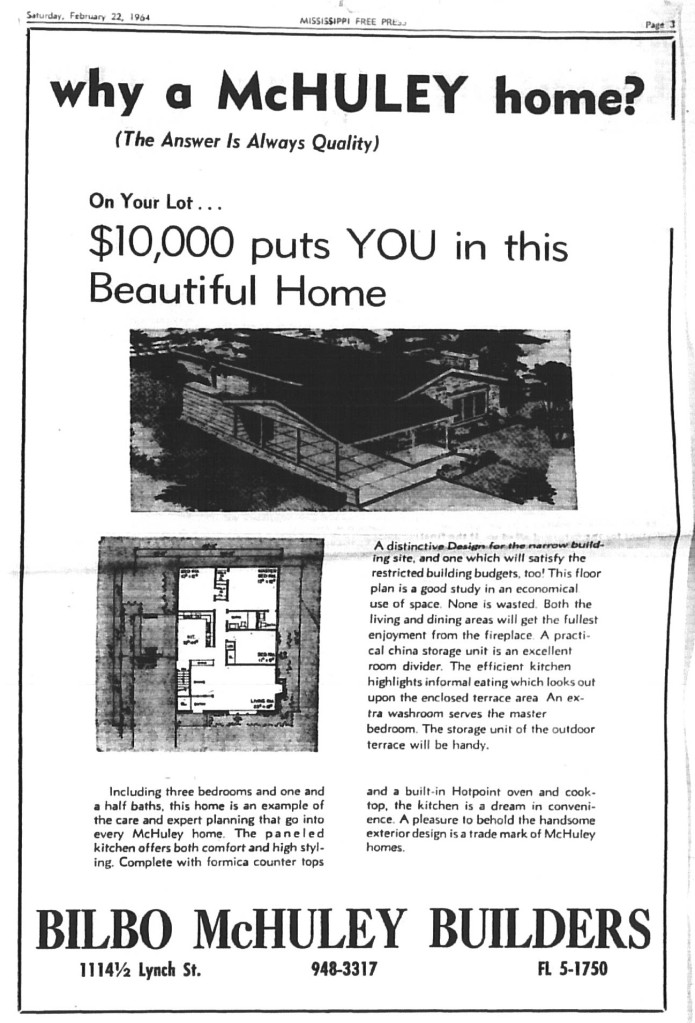Last week’s post on African American designer/architect W.A. Lattimore mentioned that he worked with builder Bilbo McHuley, and that reminded me that I’ve been sitting on this ad for a “McHuley home,” published in the February 22, 1964 edition of the Mississippi Free Press. Knowing that Lattimore was associated with McHuley in 1963, I now wonder if this modernist house plan was the work of Lattimore? If so, this may be the only drawing of Lattimore’s we have so far. Does anyone out there recognize a house like this from driving the residential streets of Jackson? I’ll bet there are more than one out there.
Suzassippi also turned up this article written towards the end of McHuley’s career in the Clarion Ledger, February 7, 1993, by Business Writer Mac Gordon (remember when we had “Business Writers” at the local newspaper? Or remember when we had “writers” at the local newspaper, and not videographers? But I digress).
Here, McHuley recounts how he got into building and how he and Lattimore met.
“I drove a truck for the Dr. Pepper Bottling Company when I came out of the Navy in 1945. But I knew I wanted to make some real money,” said McHuley, 69, who began as an on-the-job trainee at the lumber company.
“The minimum wage was only about 50 cents an hour but there were brickmasons, plasterers and capenters making $1, $1.25 an hour . . . big money for those times. It looked like the business to be in.
“The Maloneys owned a lot of property and they paid me $80 a week to take care of some of it. That gave me a good taste of the construction business.”
McHuley later worked for well-known Jackson builders Frank Maxwell and W.J. Thompson, helping construct homes across a town teeming with newly married war veterans.
“I wanted to develop. So I bought Avenue J. off of Guynes Street–me and W.A. Lattimore. He could draw and I could build, so we just got together. We learned quite a bit from each other,” McHuley said.
“Lattimore knew how to get in the door on government contracts, and we did a lot of those–the Vicksburg post office was one of our first jobs.
“The best job we had was in Memphis on three warehouses . . . until some contractor up there decided there wasn’t no contractor coming out of Mississippi to take jobs away from them.”
The MDAH Historic Resources Database seems to include all the churches that McHuley mentioned in the 1993 article as his and makes the connection between the African-American developer W.J. Thompson and the Medgar Evers House. But none of McHuley’s houses are listed. Looks like Avenue J, a one-block street, could be added to the list as a collaboration between McHuley and Lattimore.
Related posts:
Architects of Mississippi: W.A. Lattimore, African American Designer
Architects of Mississippi: Clair Maurice Jones
Categories: African American History, Architectural Research, Jackson, Modernism, Recent Past



Thanks for the follow up on Mr. McHuley. He was also an avid golfer, and helped establish the first African American Golf Club. His performance on the links made regular news in the Clarion-Ledger.
LikeLiked by 1 person
Thank you for this comment! Bilbo McHuley was my grandfather. I currently have some of his golf trophies at my home since his passing. He won and collected over 100 golf trophies over his golf career.
Thank you,
Tonga McHuley Johnson
LikeLike
At least 3 of the houses on Avenue J bear a strong resemblance to the model home photograph.
LikeLiked by 1 person
Maybe 1825 and 1835? I’m missing the other one. None of them have that carport projecting to the front like the drawing, but maybe they’re the same plan. I would never have made that connection unless he had narrowed it down to this one block though–the drawing is much more distinctive than either of these two houses are on first glance.
LikeLike
Those were the 2 I thought showed similar design, although the carports are flipped. Map view from overhead shows the odd side of the street tend to have the front gable, carport, and probable “terrace” area, and are deep and narrow. The even side is mostly end gable “square” footprint. Those resemble the ad in the Free Press that showed 1100 Bank Street as the location. Two were built in 1965, 7 in 1966, and 2 in 1969. 1831 and 1821 have the carport directly in front of the house, but have the “terrace” area to the side and a large window behind the carport entrance. I wonder if they were variations on the model house design?
LikeLike
The lone example of Rube Goldberg architecture in the historic district of Columbus, the unfinished Ma House, has been sold.
http://www.cdispatch.com/news/article.asp?aid=26358
LikeLike
Look for more historic district demolishing to be replaced by cookie-cutter developments in Starkville as the new female realtor is sworn in as mayor.
http://www.cdispatch.com/news/article.asp?aid=58713
LikeLike
Thank you for this article! Bilbo McHuley was my grandfather. I’m extremely proud to see this article representing his legacy and footprint in the Jackson, MS area. It is heartwarming to see his words in print.
Grateful Regards,
Tonga McHuley Johnson
LikeLiked by 1 person
This is an amazing article about my grandfather, Bilbo McHuley. I am so very proud of him and wish that he was still here. He was such an amazing builder and golfer.. Thanks so much for recognizing him in this article.. A true GOAT!!!
Sincere Appreciation,
Katrina McHuley-Mack
LikeLike